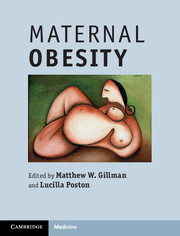Book contents
- Frontmatter
- Contents
- Contributors
- Preface
- Section 1 Trends and determinants of obesity in women of reproductive age
- 1 Demography of obesity
- 2 Determinants of obesity
- 3 Obesity and fertility
- Section 2 Pregnancy outcome
- Section 3 Long-term consequences
- Section 4 Interventions
- Section 5 Management and policy
- Index
- Plate Section
- References
2 - Determinants of obesity
from Section 1 - Trends and determinants of obesity in women of reproductive age
Published online by Cambridge University Press: 05 August 2012
- Frontmatter
- Contents
- Contributors
- Preface
- Section 1 Trends and determinants of obesity in women of reproductive age
- 1 Demography of obesity
- 2 Determinants of obesity
- 3 Obesity and fertility
- Section 2 Pregnancy outcome
- Section 3 Long-term consequences
- Section 4 Interventions
- Section 5 Management and policy
- Index
- Plate Section
- References
Summary
Introduction
Obesity has become a global epidemic. The World Health Organization’s (WHO) latest report [1] indicates that in 2008 approximately 1.5 billion adults 20 years or older worldwide were overweight, defined as having a body mass index (BMI) ≥25kg/m2 [1]. Of these, nearly 500 million were obese, BMI ≥30kg/m2, including 200 million males and nearly 300 million females. The numbers of those overweight and obese are projected to reach 2.3 billion and 700 million respectively by 2015 [1]. In the United States, the percentage of obese adults increased from 15% in the late 1970s to over 33% in 2007–2008, with the greatest increase among Mexican American women [2]. Similarly, in a number of developing countries such as China and India, where the Western lifestyle and diet are becoming more common, the prevalence of overnutrition, obesity, and obesity-related disorders is increasing rapidly. For instance, according to the WHO’s Global Information Database, 45% of males and 32% of females aged 15 years or older in China were overweight, or an average of 38.5% of the 2010 population. This is a sharp increase from the 2002 estimate of 25% in China (27.5% of males and 22.7% of females) [3].
Women of reproductive age are no exception. Based on data from the National Health and Nutrition Examination Survey (NHANES) 2007–2008, US women of 20 to 39 years old are alarmingly heavy: 60% are overweight, 34% are obese, and 8% have a BMI ≥40kg/m2 (class III obesity) [4]. Moreover, a very high proportion of pregnant women, approximately 45%, were overweight or obese when becoming pregnant [5]. Furthermore, in the United States, the greatest increase in the prevalence of obesity in the past decade is among women aged 20 to 39 years, a jump from 28% during 1999–2000 to 34% during 2007–2008, as compared with a slight increase from 37.8% to 38.4% among women of 40 to 59 years old. Substantial increase in obesity burden among women at reproductive age was observed in other countries as well. For instance, in a nationally representative study of maternal obesity in England, UK, first trimester maternal obesity more than doubled from 7.6% in 1989 to 15.6% in 2007 (p < 0.001) [6]. In South Asian countries (Bangladesh, Nepal, and India), although the prevalence of underweight has remained high, the prevalence of overweight and obesity in women of reproductive age has increased substantially [7].
Keywords
- Type
- Chapter
- Information
- Maternal Obesity , pp. 8 - 19Publisher: Cambridge University PressPrint publication year: 2012
References
- 1
- Cited by

